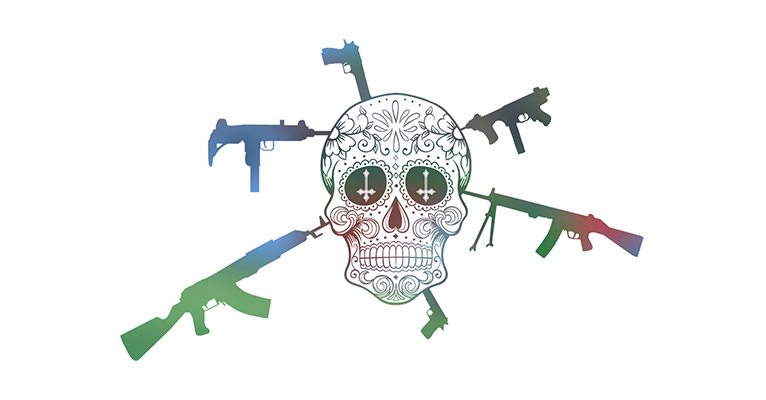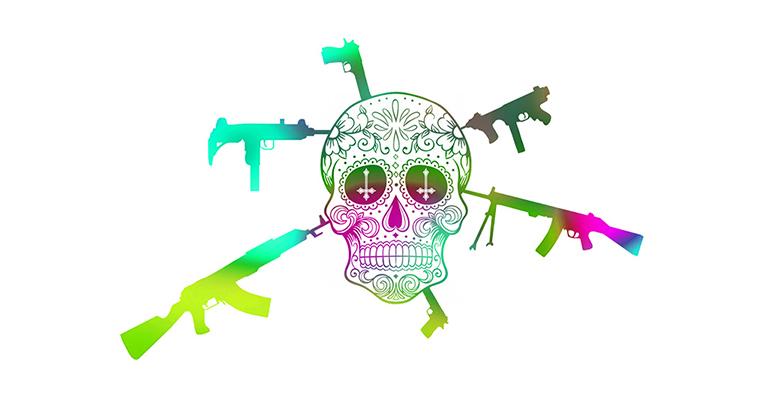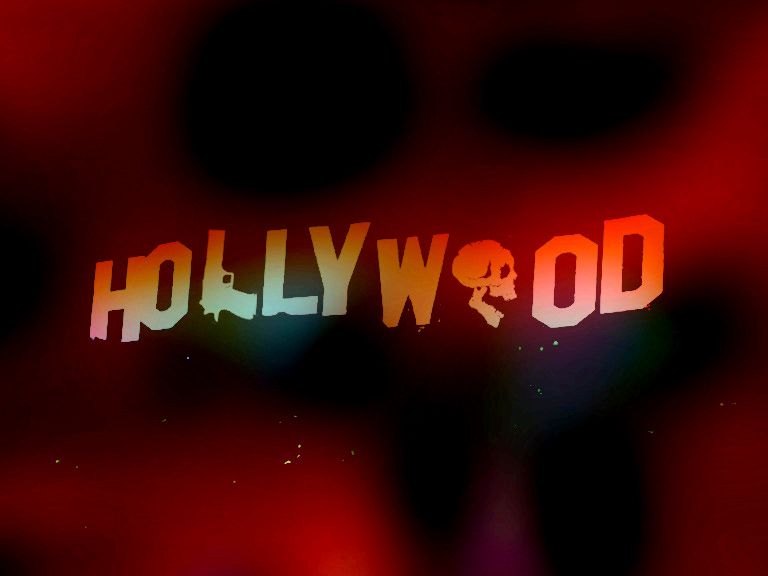Day of the Dead Rhetoric
IN recent years, Hollywood seems to have decided that the war on drugs is more complicated than “Just Say No.” The rising cartel-driven slaughter in Mexico, the heroin and prescription-drug epidemic hitting white Americans in the Rust Belt, and voter-approved marijuana legalization in multiple Western states have punctured the safe bubble in which Reagan-era bromides hid the problem. As a result, the cartoonish drug lords of films like 1983’s Scarface have been replaced. Popular TV series like Narcos, now in its second season on Netflix, and films like Sicario (2015) from Denis Villeneuve, have layered, nuanced characters sketched against a complex geopolitical background.
These new stories even begin to wrestle with the fact that the U.S. is a full partner in the international violence surrounding our war on drugs. After all, the global drug war is a war of choice for the U.S. It’s a transnational military enterprise that costs the U.S. more than $40 billion per year, and bears a large share of the responsibility for our massive carceral state. It has affected our international geopolitical allegiances, and it drives our policy decisions in Latin America. At home and abroad, the drug war has been one of the U.S.’s furthest-reaching policy choices of the past several decades, an endless unintended consequence. Looking for a terminus will leave you stuck in an infinite loop.
Some parts of this story are now reflected in Hollywood. That the drug war affects people who aren’t American, for instance, is now understood: Narcos is not only the story of U.S Drug Enforcement Administration agent Steve Murphy’s hunt to bring Escobar down, but also the saga of Pablo Escobar’s transformation into Colombia’s top drug lord. Colombia -- with its lush forests, spectacular colonial cities, resourceful and family-oriented people -- is a central character in Narcos. We are allowed to feel sorrow as we watch narcotrafficking rip this beautiful country apart, and to feel conflicted the American drug cop is shown killing innocent civilians, endangering his fellow agents, and tampering with evidence. The war on drugs can taint even the good guys, Narcos reminds us; even a white man can break bad.
But this is also the problem: the “good guys” are still the American cops. We know this because Murphy tells us so. “The bad guys need to get lucky every time,” Murphy drawls in voice-over during the first season, in his West Virginia twang. “The good guys just need to get lucky once.” In the second season, we find Murphy’s can-do spirit undimmed: “We represented America down here,” Murphy says in the first episode. “We thought of ourselves as the guys who could get shit done.”
The choice of Murphy as Narcos’ narrator illustrates the shortcoming of Hollywood’s new approach to the drug war, which has its own bumper-sticker sayings. However proud Narcos is of its historicism -- its bilingual format, the fact that its Colombian drug traffickers are fully characterized with backstories and families, its photography with the yellowed tones of 1970s’ film emulsion, and its haircuts and lapels with their period-piece perfection -- the series’ politics are equally retrograde. Narcos not only assumes that its viewer is an American (and that you believe in the basic correctness of the U.S. drug enforcement agency’s mission), but it bends its narrative to fit this ideological desire. Why, after all, are we following Murphy? The real-life Murphy didn’t bring Escobar to justice in a final fiery shootout; that was the Colombian police. And never mind that U.S. drug agents have escalated as many conflagrations in Latin America as they’ve prevented. The governing simplicity of the drug war demands an easy storyline, with U.S. law enforcement at the center. Narcos is more than happy to deliver it.
More sophisticated than Narcos, Sicario is haunted by the impact that the drug war has had on everyday people in the Americas. The stories of migrants fleeing their homes, or of families in Ciudad Juárez who try to carry on a soccer game despite nearby gunfire, pose questions for the U.S. viewer: Is this the status quo we want? Is this bleakness worth the moral righteousness of our endless battle on drugs? In Juárez, the camera pans over torn posters of missing women, a reference to that city’s hundreds of unsolved femicides. A subplot about an impoverished Mexican police officer and his young family demonstrates all the reasons why so many Mexicans have succumbed to the temptation of corruption. Even affluent Mexicans are revealed to be psychologically destroyed by the effects of cartel violence. We may not see the fallout from the drug war on U.S. streets, but Sicario shows us where it’s all too visible.
Yet Sicario offers similar frustrations as Narcos. Like a revisionist Western from the 1970’s, Sicario does complicate the heroic figure of the U.S. lawman. Emily Blunt plays Kate Macer, an FBI agent who stumbles into an extralegal task force attempting to take out a Mexican drug lord. She’s recruited by Matt Graver, a CIA agent played by Josh Brolin. When Graver shrugs off legal protocol and rails against U.S. complicity in the drug war, we see a familiar type -- the loose cannon, railing against a dysfunctional system. But the most important decision Villeneuve made in Sicario was to place another U.S. law officer at the center of the movie. Everything else is subordinated to this essential cops-and-bandits narrative. Macer is thrust into a maelstrom of amorality; as a hard-working but under-informed FBI agent, she’s a stock figure, the innocent abroad. The U.S. viewer might learn some of the moral complexity of the war on drugs, but we still can’t seem to shake the old familiar fables.

THE correctives are on the other side of the border. Observers in Latin America have been telling their own drug war stories, and they serve as useful counterpoints to the morality plays we see on U.S. screens. If we’re to have an accurate view of our own drug war, it’s crucial to read them. The alternative is to keep believing in the simple narrative and simple solutions that have already failed us.
U.S. institutions have played a significant role in the rise of the drug cartels. In A Narco History: How the United States and Mexico Jointly Created the “Mexican Drug War,” Carmen Boullosa and Mike Wallace explain how the U.S.’s militarized crusade against drugs -- coupled with neoliberal development policies and free-trade agreements that impoverished Mexican farmers -- contributed to the growth of centralized narcotrafficking syndicates:
Farmers, unable to sustain themselves due to the removal of subsidies and the arrival of competition from U.S. agri-corporations, found the burgeoning market for marijuana and poppies their only avenue to surviving on the land. The army of the unemployed gave the cartels a deep pool from which to recruit foot soldiers, and the miserably paid (and eminently corruptible) police and military provided the muscle with which to protect their interests.
Meanwhile, Reagan’s 1986 Anti-Drug Act required any country receiving U.S. assistance to fully cooperate with U.S. anti-narcotics efforts. This served as assurance that a succession of Mexican presidents would wage war on the cartels. The battle lines were set for endless war.
Ciudad Juárez is of particular interest to the authors, a prize for the cartels because of the city’s location near an entry point to the U.S. drug market. In the late 00’s, the Sinaloa and Juárez cartels turned the city into a battlefield. When Mexico’s military showed up, at the behest of then-president Felipe Calderon, they write, Juárez turned into an “inferno.” To assert state control, the military executed a terror mission against the citizenry, “stealing, raping, robbing, and kidnapping at will.” By August 2009, Juárez had the world’s highest murder rate. Tens of thousands of residents fled. Yet multiple U.S. presidents have encouraged Mexican leaders to use the country’s military against the cartels, imagining it to be a more effective force than (hopelessly corrupt) local police divisions.
To truly unravel the drug war, the authors argue, the U.S. and Mexico must re-balance their entire relationship. Trade policy is drug policy. The drug trade employs at least half a million people in Mexico and brings in receipts of up to $30 billion a year, or an estimated 3-4% of Mexico’s GDP. Fighting the drug traffic with military force only assures that the biggest, best-capitalized, and most ruthless cartels will be left in control: “The drug business, whose illicit cargos rolled north from Nuevo Laredo and Ciudad Juárez alongside the trucks conveying automobiles and electronics, (is) itself part of the New Mexico,” Boullosa and Wallace write.
Of course, Mexico is far from the only country in the Americas to be warped by the drug war. The war’s center of gravity is shifting south. The U.S. woke up to this changing geography only recently, when a refugee crisis appeared on its doorstep. But in tiny El Salvador, the battle between major narcotrafficking gangs La Mara Salvatrucha and the 18th Street gang has led to a death toll rivaling the worst years of that country’s 1980-92 civil war. With a 2015 homicide rate of 103 per every 100,000 inhabitants, El Salvador is the world’s most violent country. Both La Mara Salvatrucha and the 18th Street gang have U.S. origins: the gangs were born on the streets of Los Angeles and nurtured in the U.S. prison system. Gang members wound their way down the tropical coast of Central America via U.S. deportations.

El Salvador’s best chronicler of this profound crisis is Óscar Martínez, a journalist based in San Salvador. Martínez has dedicated his career to documenting how the matrix of poverty, instability, and narcotrafficking has transformed the lives and prospects of Central Americans. As a writer, he’s a committed, old-school social realist, and traveled with migrants on their deadly northward route for his previous book about Central American migration, The Beast. His methods in A History of Violence: Living and Dying in Central America are equally painstaking. To understand Central America’s rates of extreme violence, Martínez visited traffickers at their homes, talked to gang members in prisons, and went into the field with El Salvador’s lone forensic scientist as the man fought a Sisyphean struggle for equipment to exhume a mass grave.
In A History of Violence, Martínez also picked a drug war narrator: a 27-year-old hit man and crack user named El Niño Hollywood.
This Hollywood gives us something different than a DEA agent on a moral mission, or an FBI agent who’s in over her head. El Niño Hollywood’s name is real, a salute to the Hollywood clique of Mara Salvatrucha for which he was a sicario. It also stands as a rebuke to the industry presentation of Narcos and Sicario as brave commentary.
Martínez wants his readers to understand what a good guy looks like in the drug war. So we sit with El Niño Hollywood as he sweats it out in a shack under the dubious protection of corrupt police officers. We learn about his backstory. El Niño Hollywood spent most of his youth decapitating targets, amputating traitors, ripping out men’s hearts, shooting his own friends in the head. Then he decided to stop the leaders of his gang. For reasons that remain opaque even to himself, El Niño went to the authorities. It’s a heroic, suicidal act. El Niño -- a murderer -- is one of the good guys.
We watch the formerly flush assassin try to feed his family on beans and salsa because the Salvadoran justice system offers so few resources for state-protected witnesses. We follow his testimony as he provides the police and the attorney general of El Salvador with the evidence they need to capture, try, and convict more than thirty members of the Hollywood, Parvis, and Ángeles cliques of the Salvatrucha (including the two men who turned El Niño into a killing machine when he was a child). We sit in on his conversations with Martínez about what he wants from his country in return. He would be satisfied, El Niño says, if he could get a job. We reason with him as he buys a trabuco (hand cannon), not for his growing list of enemies, but for himself. Mara Salvatrucha is closing in, El Niño tells us; and if necessary, he’d rather die a clean death by his own hand. We note the absolute absence of U.S. law enforcement and the constructive absence of any effective Salvadoran institution.
In Martínez’s world, law enforcement isn’t bumbling, meddling, or corrupt. It’s irrelevant. Where were these institutions when El Niño was a child? How could they have given him an opportunity, or a job, that might have kept him from becoming an adolescent killer? By the time any lawman gets involved, hope is already gone. The most heroic official Martínez finds in El Salvador is the one with the fewest resources: the forensic scientist, a man who just wants to give families the peace of knowing where their loved ones are buried.
Boullosa and Wallace found similar heroism in Mexico. In 2014 a group of student teachers from Ayotzinapa commandeered a bus in a desperate attempt to draw government attention to the derelict state of their school. They were disappeared by police in Iguala, who acted at the request of that town’s cartel-linked mayor and his wife. The bodies of the students are believed to have been burned in a ravine. But they haven’t been forgotten. Their furious parents launched a movement to root out government venality, which has been eagerly taken up by other Mexicans. Even now, their movement threatens the political survival of Mexico’s deeply unpopular president Enrique Peña Nieto.
Decent people who simply want to bury those who never should have been killed: their moral force inspires the chroniclers of the drug war in Latin America. Martínez, Boullosa, and Wallace never mislead their readers into believing that the drug war can be won with guns, jail sentences, or military operations. They are never tempted to believe in bumper-sticker solutions. The people of the Americas must save themselves, and it won’t be a Hollywood story of law men killing bandits.
That’s the lesson for U.S. readers, too. Latin America can’t shoot its way out of the drug trade, and we can’t either. The sooner we bury our dead rhetoric, the more lives we’ll save.
